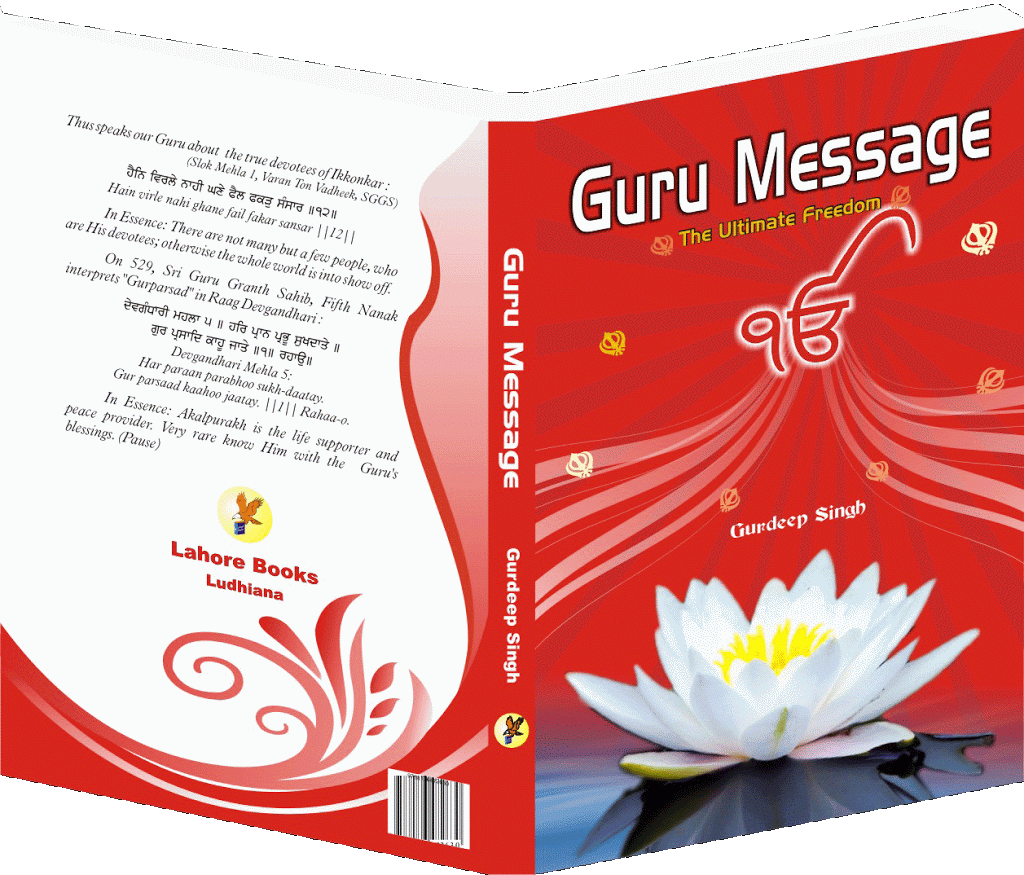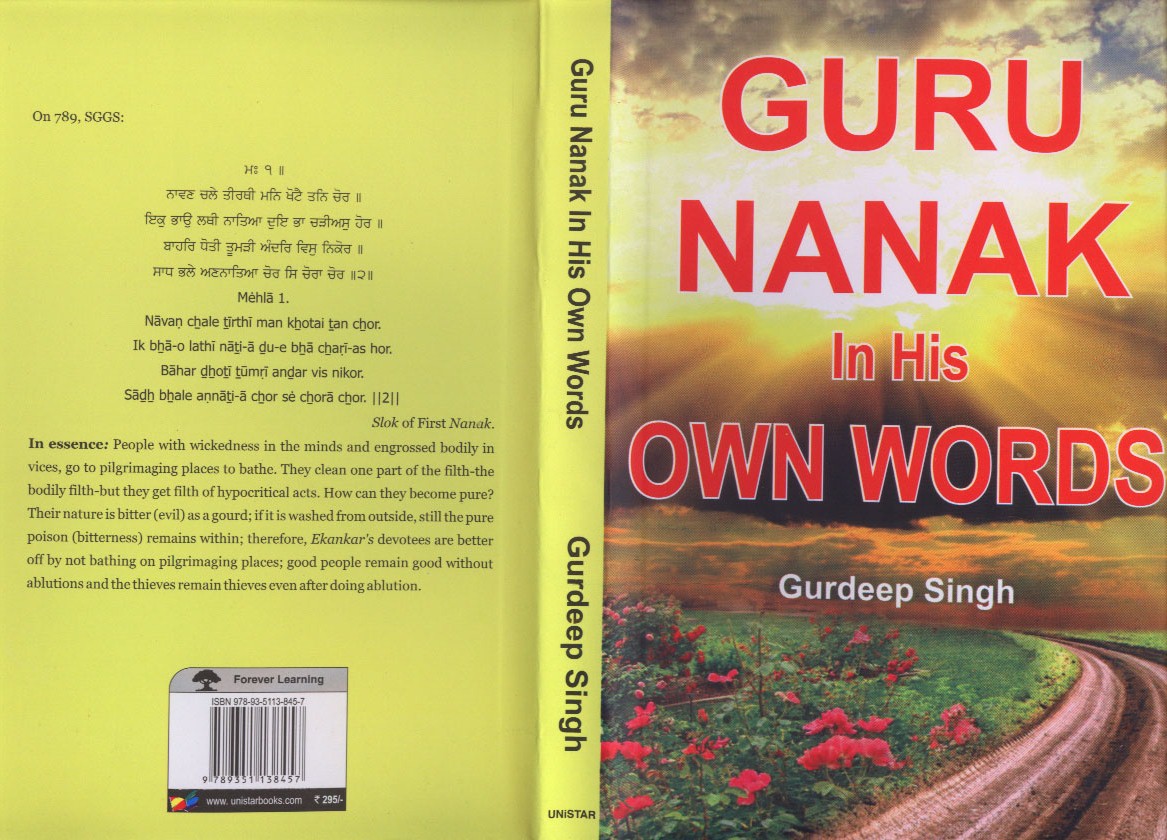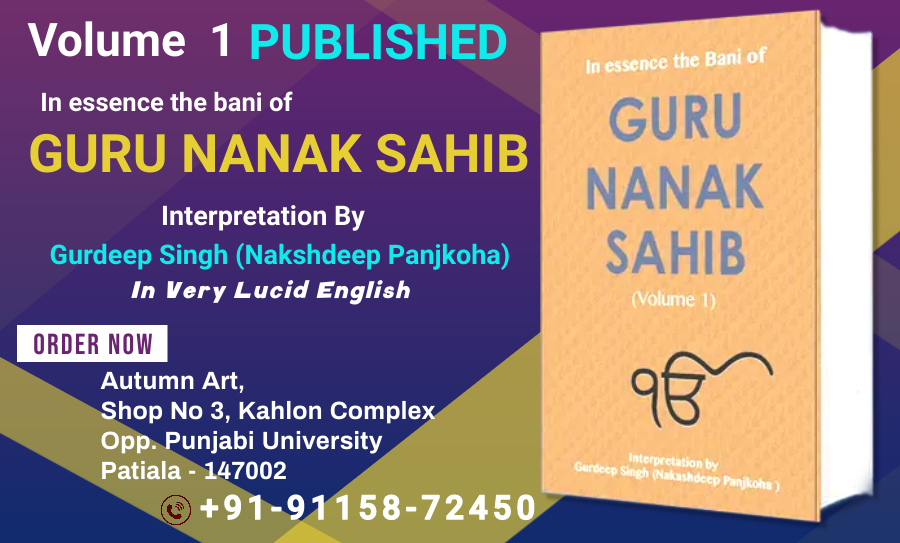Seeing what is being done on religious ceremonies of Sikh gatherings, I doubt if today’s’ Sikhi is different than the Hinduism’s ritual- drenched culture. Many rituals and rites are done at ceremonies such as Akhand path (continuous recitation of Sri Guru Granth Sahib) without caring what Guru says about such rites or rituals in Sri Guru Granth Sahib. Every routine is taken over by this or that ritual. First Nanak meticulously made it clear to his followers (Sikhs) that the devotion of Akalpurakh doesn’t need any ritual or rites but His praise done with a pure mind, and to purify the mind, negative inclinations need to be dumped once for all. That is what all his descendent –Gurus preached after him. To purify the mind through the Guru guidance is what is difficult to do; otherwise, the act of performing rituals and rites is nothing but a conditional act which can be done with absent mind; therefore, most of the people go for it. For Sikhs, such a meaningless practice is forbidden in Gurbani; it is repeatedly declared as hypocritical behavior. Sikhi actually doesn’t need any garb, ritual or rite; it needs a pure heart devoted for Akalpurakh and the Guru; it is a life commitment not to the family, friend or anybody else but to the Guru who gives his word to unite with Invisible and all Omnipotent Akalpurakh only on one condition, and that is to live as his instructions. When, as Sikhs, we go and join ritual inflicted culture, we die as Sikhs. In this article, I shall give you Gurbani quotes that forbid us to become what we have become today.
On 1332, SGGS:
ਸਗਲੇ ਕਰਮ ਧਰਮ ਸੁਚਿ ਸੰਜਮ ਜਪ ਤਪ ਤੀਰਥ ਸਬਦਿ ਵਸੇ ॥
Sagle karam ḏẖaram sucẖ sanjam jap ṯap ṯirath sabaḏ vase.
In Essence: All deeds of religious faith like purification, self discipline, chanting, intense meditation (penance) and doing pilgrimage to sacred shrines, abide in (following) the Guru Shabda.
We should follow the Guru by uttering Prabh’s Name and His virtues with a commitment to become immaculate; following the Guru frees us from the useless acts done in the name of religion.
On 747, SGGS:
ਸੂਹੀ ਮਹਲਾ ੫ ॥
ਕਰਮ ਧਰਮ ਪਾਖੰਡ ਜੋ ਦੀਸਹਿ ਤਿਨ ਜਮੁ ਜਾਗਾਤੀ ਲੂਟੈ ॥
ਨਿਰਬਾਣ ਕੀਰਤਨੁ ਗਾਵਹੁ ਕਰਤੇ ਕਾ ਨਿਮਖ ਸਿਮਰਤ ਜਿਤੁ ਛੂਟੈ ॥੧॥
Sūhī mėhlā 5.
Karam ḏẖaram pakẖand jo ḏīsėh ṯin jam jāgāṯī lūtai.
Nirbāṇ kīrṯan gāvhu karṯe kā nimakẖ simraṯ jiṯ cẖẖūtai. ||1||
Raag Soohi: Bani of Fifth Nanak:
In Essence: The people, who are seen doing the hypocritical religious deeds, are plundered by the fear of death (tax collecting-act is used here as a painful act). Sing praises of the Creator without hoping for any reward, because by doing it for a moment, one is saved.
Many times I wonder why my Sikh brothers and sisters feel nostalgia for going to other doors to seek spirituality when our Guru gives us very simple and clear directions to seek union of Akalpurakh. Is it because incorrect information about Sikhi has been passed on to our psyche over years or we are just too lazy to consult our Guru who is all the time available! I witnessed many Sikhs traveling with threads tied around their wrists. I also witnessed a lot of so called Sikh- population running to various sects for something I couldn’t understand. As per Gurbani, it is totally unacceptable to worship Ganesha, Naina Devi or any other entity; however, some so called Sikhs are doing it any way. As some weak people become ready to bow before anything to fulfill Maya littered wishes, some Sikhs of today are in the same kind of plight. They forsake freedom the Guru has provided and embrace slavery of idols and other entities. I wondered a lot, why? I was stunned to hear one of my own relatives, who happened to be devoted Sikh, saying“All are the same”. I asked, “If that was correct, why Guru Nanak needed to guide us toward Akalpurakh instead of wasting life in deity worship? These “all the same ones” were also there in his times, weren’t they?’ I didn’t get any satisfactory answer. I refuse to blame others in this regard; I don’t feel comfortable either to put blames on the heads of various sects who are on high gear to attract “once Guru Nanak Gobind Singh followers”. I feel, we are totally failed to pass on our Guru’s Message to our generation. We are too busy in confusing Guru –concept in Sri Guru Granth Sahib. We are even failed to overcome disgusting caste system. Education about Gurbani is not Gurbani – based, but it is sculptured one to fit well with those who have become masters of this task; in India or abroad, academic institutions are more into muscular debates or to fetch degrees to make a living, and who want to learn from Gurbani, cannot learn from them much in this regards. There are the groups out there which are into making money by creating controversy on everything belonging to Sikhi. If we read their assays on Guru Nanak and Guru Gobind Singh, their purpose becomes clear and that is to make thought of the Gurus fit to the guide lines drawn by the people in power. Surprisingly, Sikh Guru Message is very daring and quite contrary to those who just want to blend in the society to grind their own axe. Source of Sikh History are tainted ones, the only avenue left for a true Guru follower is Sri Guru Granth Sahib according to which all religions and sects are here as per the Will of the Creator; however, only through a true Guru, who has envisioned Akalpurakh, one can learn about His path. Only the true Guru is capable of showing Akalpurakh to others as well. Sri Guru Granth Sahib doesn’t promote hypocrisy or policy of keeping lips tied because of fear of losing jobs or facing other tough choices. Sri Guru Granth Sahib promotes world peace by saying that the whole world is His big family and we must behave with all in a proper way without bearing any malice or animosity even if they are in disagreement with us; if we have to avoid some people, we must not hate them in any situation. I believe all people, who are indulged in passing on the Guru Message, should rely only on Sri Guru Granth Sahib to guide Sikhs by making it clear to the public that Sikh Gurus do not believe in prevailed religions, caste system or Maya Show; however, they don’t criticize them either save for hypocritical lives of the believers of various faiths. It should be stressed that no other religious scripture should be trashed save for referring their virtuous teachings. It is a big subject to address in a small essay; however, I am going to introduce a Guru Shabada by First Nanak that states very clearly what the Sikhs should do and in whom they should believe to remain free from any kind of fears, worries and doubts to obtain ultimate freedom of the mind; this Shabada is on 634-635 SGGS in Raag Sorath, Mehla 1
ਦੁਬਿਧਾ ਨ ਪੜਉ ਹਰਿ ਬਿਨੁ ਹੋਰੁ ਨ ਪੂਜਉ ਮੜੈ ਮਸਾਣਿ ਨ ਜਾਈ ॥
ਤ੍ਰਿਸਨਾ ਰਾਚਿ ਨ ਪਰ ਘਰਿ ਜਾਵਾ ਤ੍ਰਿਸਨਾ ਨਾਮਿ ਬੁਝਾਈ ॥
ਘਰ ਭੀਤਰਿ ਘਰੁ ਗੁਰੂ ਦਿਖਾਇਆ ਸਹਜਿ ਰਤੇ ਮਨ ਭਾਈ ॥
ਤੂ ਆਪੇ ਦਾਨਾ ਆਪੇ ਬੀਨਾ ਤੂ ਦੇਵਹਿ ਮਤਿ ਸਾਈ ॥੧॥
Ḏubiḏẖā na paṛa▫o har bin hor na pūja▫o maṛai masāṇ na jā▫ī.
Ŧarisnā rācẖ na par gẖar jāvā ṯarisnā nām bujẖā▫ī.
Gẖar bẖīṯar gẖar gurū ḏikẖā▫i▫ā sahj raṯe man bẖā▫ī.
Ŧū āpe ḏānā āpe bīnā ṯū ḏevėh maṯ sā▫ī. ||1||
In Essence: I shall not fall into duality, I shall not worship any one other than Akalpurakh, and I shall not go to bow to burials or crematoriums; Name of Akalpurakh has stilled my mind; therefore, by getting engrossed in desire, I don’t go to others homes (the desires just don’t exist because of being in love with Him) The Guru has shown me His abode in me, I am drenched in His love, and my mind is pleased being in this equipoise. (A prayer of thanks) Oh Prabh! You know all! You understand what is in my mind. You give me this wisdom, oh my Master!
It is made clear by our Guru that there is none worth worshiping but Akalpurakh; because of that strong faith in Him, there should be no fear of any kind in the mind of a Sikh, and no other door needs to be knocked at for help. We, Sikhs, must learn to fall for our Creator with utter honesty. Our attention shouldn’t be at worldly show off or on others who are into beating drums of other entities; there is literally none who is equal to the Creator in power and bestowing of gifts. If we face hard times, our prayer should be addressed to the Creator, and we should be ready how He takes our prayer without a question, because we are in love with Him and in love there are no conditions.
In the next Guru Vaakas, Guru Nanak defines how seriously Guru teachings should be taken. The Guru Shabad are not just for singing and listening but to sculpture our minds according to what the Guru says through them; First Nanak verifies that fact in the following, please read on:
ਦੁਬਿਧਾ = ਦੁ-ਪਾਸਾ-ਪਨ, ਪਰਮਾਤਮਾ ਤੋਂ ਬਿਨਾ ਹੋਰ ਆਸਰੇ ਦੀ ਭਾਲ। ਨ ਪੜਉ = ਮੈਂ ਨਹੀਂ ਪੈਂਦਾ। ਨ ਪੂਜਉ = ਮੈਂ ਨਹੀਂ ਪੂਜਦਾ। ਮੜੈ = ਸਮਾਧ, ਕਬਰ। ਮਸਾਣਿ = ਸ਼ਮਸ਼ਾਨ, ਜਿੱਥੇ ਮੁਰਦੇ ਫੂਕੀਦੇ ਹਨ। ਨ ਜਾਈ = ਮੈਂ ਨਹੀਂ ਜਾਂਦਾ। ਰਾਚਿ = ਫਸ ਕੇ। ਪਰ ਘਰਿ = ਪਰਾਏ ਘਰ ਵਿਚ, ਪਰਮਾਤਮਾ ਤੋਂ ਬਿਨਾ ਕਿਸੇ ਹੋਰ ਘਰ ਵਿਚ। ਨਾਮਿ = ਨਾਮ ਨੇ। ਬੁਝਾਈ = ਬੁਝਾ ਦਿੱਤੀ ਹੈ। ਭੀਤਰਿ = ਅੰਦਰ। ਘਰੁ = ਪਰਮਾਤਮਾ ਦਾ ਨਿਵਾਸ। ਸਹਜਿ = ਅਡੋਲ ਅਵਸਥਾ ਵਿਚ। ਮਨ = ਮਨ ਨੂੰ। ਭਾਈ = ਪਸੰਦ ਆ ਗਈ ਹੈ। ਦਾਨਾ = ਜਾਣਨ ਵਾਲਾ। ਬੀਨਾ = ਪਛਾਣਨ ਵਾਲਾ। ਸਾਈ = ਹੇ ਸਾਈਂ!।੧।
ਮੈਂ ਪਰਮਾਤਮਾ ਤੋਂ ਬਿਨਾ ਕਿਸੇ ਹੋਰ ਆਸਰੇ ਦੀ ਭਾਲ ਵਿਚ ਨਹੀਂ ਪੈਂਦਾ, ਮੈਂ ਪ੍ਰਭੂ ਤੋਂ ਬਿਨਾ ਕਿਸੇ ਹੋਰ ਨੂੰ ਨਹੀਂ ਪੂਜਦਾ, ਮੈਂ ਕਿਤੇ ਸਮਾਧਾਂ ਤੇ ਮਸਾਣਾਂ ਵਿਚ ਭੀ ਨਹੀਂ ਜਾਂਦਾ। ਮਾਇਆ ਦੀ ਤ੍ਰਿਸ਼ਨਾ ਵਿਚ ਫਸ ਕੇ ਮੈਂ (ਪਰਮਾਤਮਾ ਦੇ ਦਰ ਤੋਂ ਬਿਨਾ) ਕਿਸੇ ਹੋਰ ਘਰ ਵਿਚ ਨਹੀਂ ਜਾਂਦਾ, ਮੇਰੀ ਮਾਇਕ ਤ੍ਰਿਸ਼ਨਾ ਪਰਮਾਤਮਾ ਦੇ ਨਾਮ ਨੇ ਮਿਟਾ ਦਿੱਤੀ ਹੈ। ਗੁਰੂ ਨੇ ਮੈਨੂੰ ਮੇਰੇ ਹਿਰਦੇ ਵਿਚ ਹੀ ਪਰਮਾਤਮਾ ਦਾ ਨਿਵਾਸ-ਅਸਥਾਨ ਵਿਖਾ ਦਿੱਤਾ ਹੈ, ਅਤੇ ਅਡੋਲ ਅਵਸਥਾ ਵਿਚ ਰੱਤੇ ਹੋਏ ਮੇਰੇ ਮਨ ਨੂੰ ਉਹ ਸਹਿਜ-ਅਵਸਥਾ ਚੰਗੀ ਲੱਗ ਰਹੀ ਹੈ। ਹੇ ਮੇਰੇ ਸਾਈਂ! (ਇਹ ਸਭ ਤੇਰੀ ਹੀ ਮੇਹਰ ਹੈ) ਤੂੰ ਆਪ ਹੀ (ਮੇਰੇ ਦਿਲ ਦੀ) ਜਾਣਨ-ਵਾਲਾ ਹੈਂ; ਆਪ ਹੀ ਪਛਾਣਨ ਵਾਲਾ ਹੈਂ, ਤੂੰ ਆਪ ਹੀ ਮੈਨੂੰ (ਚੰਗੀ) ਮਤਿ ਦੇਂਦਾ ਹੈਂ (ਜਿਸ ਕਰਕੇ ਤੇਰਾ ਦਰ ਛੱਡ ਕੇ ਹੋਰ ਪਾਸੇ ਨਹੀਂ ਭਟਕਦਾ)।੧।
ਮਨੁ ਬੈਰਾਗਿ ਰਤਉ ਬੈਰਾਗੀ ਸਬਦਿ ਮਨੁ ਬੇਧਿਆ ਮੇਰੀ ਮਾਈ ॥
ਅੰਤਰਿ ਜੋਤਿ ਨਿਰੰਤਰਿ ਬਾਣੀ ਸਾਚੇ ਸਾਹਿਬ ਸਿਉ ਲਿਵ ਲਾਈ ॥ ਰਹਾਉ ॥
Man bairāg raṯa▫o bairāgī sabaḏ man beḏẖi▫ā merī mā▫ī.
Anṯar joṯ niranṯar baṇī sācẖe sāhib si▫o liv lā▫ī. Rahā▫o.
In Essence: Oh my mother! My mind is imbued with the Guru Shabada, and because of that, my mind feels separation from the Creator. That person feels about separation from Him who is occupied internally with the bani of continuous praise of Akalpurakh, and who remains meditated on the Master. Pause
Please try to look out for the sincerity expressed toward the Guru Shabad; it is said that with the Guru Shabada, mind is taken in control to remain in love with the Creator. When that occurs, our state of mind is changed because our souls are lifted up by the Guru – word. Gurbani directs our minds to live our lives by remaining focused on Akalpurakh. Living should become an experience of being totally absorbed in our Creator. It can be experienced but for that, the Guru Shabada should be deemed as the only light that can take us to that state of mind. When the Guru is followed sincerely, wandering from one place to another is stopped; the desire to seek help from this or that establishment is ceased. Then one enjoys a real and pure freedom. In this state, the mind becomes fearless and worry- free. Though the ultimate decision is, as per Gurbani, in the hands of the Creator, even then, whatever His decision may be, it should be treated as His grace. If you want this freedom, you have to pay for this: you need to get rid of lust, greed, anger, self conceit and attachment.
We belong to our Creator and only our Creator deserves worshiping, all other so called “givers” are at His mercy. What can they give to us? Follow the Guru and enjoy the taste of ultimate freedom the First Nanak introduced centuries ago.
ਬੈਰਾਗਿ = ਵੈਰਾਗ ਵਿਚ, ਵਿਛੋੜੇ ਦੇ ਅਹਿਸਾਸ ਵਿਚ, ਬਿਰਹੋਂ ਵਿਚ। ਰਤਉ = ਰੰਗਿਆ ਹੋਇਆ। ਬੈਰਾਗੀ = ਤਿਆਗੀ। ਬੇਧਿਆ = ਵਿੱਝਿਆ ਹੋਇਆ। ਨਿਰੰਤਰਿ = ਵਿੱਥ ਤੋਂ ਬਿਨਾ, ਇੱਕ-ਰਸ।ਰਹਾਉ।
ਹੇ ਮੇਰੀ ਮਾਂ! ਮੇਰਾ ਮਨ ਗੁਰੂ ਦੇ ਸ਼ਬਦ ਵਿਚ ਵਿੱਝ ਗਿਆ ਹੈ (ਪ੍ਰੋਤਾ ਗਿਆ ਹੈ। ਸ਼ਬਦ ਦੀ ਬਰਕਤਿ ਨਾਲ ਮੇਰੇ ਅੰਦਰ ਪਰਮਾਤਮਾ ਤੋਂ ਵਿਛੋੜੇ ਦਾ ਅਹਿਸਾਸ ਪੈਦਾ ਹੋ ਗਿਆ ਹੈ)। ਉਹੀ ਮਨੁੱਖ (ਅਸਲ) ਤਿਆਗੀ ਹੈ ਜਿਸ ਦਾ ਮਨ ਪਰਮਾਤਮਾ ਦੇ ਬਿਰਹੋਂ-ਰੰਗ ਵਿਚ ਰੰਗਿਆ ਗਿਆ ਹੈ। ਉਸ (ਬੈਰਾਗੀ) ਦੇ ਅੰਦਰ ਪ੍ਰਭੂ ਦੀ ਜੋਤਿ ਜਗ ਪੈਂਦੀ ਹੈ, ਉਹ ਇਕ-ਰਸ ਸਿਫ਼ਤਿ-ਸਾਲਾਹ ਦੀ ਬਾਣੀ ਵਿਚ (ਮਸਤ ਰਹਿੰਦਾ ਹੈ), ਸਦਾ ਕਾਇਮ ਰਹਿਣ ਵਾਸਤੇ ਮਾਲਕ-ਪ੍ਰਭੂ (ਦੇ ਚਰਨਾਂ ਵਿਚ) ਉਸ ਦੀ ਸੁਰਤਿ ਜੁੜੀ ਰਹਿੰਦੀ ਹੈ।੧।ਰਹਾਉ।
ਅਸੰਖ ਬੈਰਾਗੀ ਕਹਹਿ ਬੈਰਾਗ ਸੋ ਬੈਰਾਗੀ ਜਿ ਖਸਮੈ ਭਾਵੈ ॥
ਹਿਰਦੈ ਸਬਦਿ ਸਦਾ ਭੈ ਰਚਿਆ ਗੁਰ ਕੀ ਕਾਰ ਕਮਾਵੈ ॥
ਏਕੋ ਚੇਤੈ ਮਨੂਆ ਨ ਡੋਲੈ ਧਾਵਤੁ ਵਰਜਿ ਰਹਾਵੈ ॥
ਸਹਜੇ ਮਾਤਾ ਸਦਾ ਰੰਗਿ ਰਾਤਾ ਸਾਚੇ ਕੇ ਗੁਣ ਗਾਵੈ ॥੨॥
Asaʼnkẖ bairāgī kahėh bairāg so bairāgī jė kẖasmai bẖāvai.
Hirḏai sabaḏ saḏā bẖai racẖi▫ā gur kī kār kamāvai.
Ėko cẖeṯai manū▫ā na dolai ḏẖāvaṯ varaj rahāvai.
Sėhje māṯā saḏā rang rāṯā sācẖe ke guṇ gāvai. ||2||
In Essence: There are countless who talk about having feeling of detachment because of separation from Him, but real detached one is he with whom the Creator is pleased; in that person’s heart, His fear exists always, and he lives as per the Guru – guidance. The mind of such person contemplates only one Akalpurakh, it remains stilled and doesn’t wander in different directions. Intuitively his mind is always drenched in His love and it sings virtues of the eternal Creator.
ਅਸੰਖ = ਬੇਅੰਤ। ਬੈਰਾਗ = ਵੈਰਾਗ ਦੀਆਂ ਗੱਲਾਂ। ਭੈ = ਪਰਮਾਤਮਾ ਦੇ ਡਰ-ਅਦਬ ਵਿਚ। ਧਾਵਤੁ = ਮਾਇਆ ਵਲ ਦੌੜਦੇ ਨੂੰ। ਰਹਾਵੈ = ਕਾਬੂ ਰੱਖਦਾ ਹੈ। ਸਹਜੇ = ਸਹਿਜ ਵਿਚ।੨।
ਅਨੇਕਾਂ ਹੀ ਵੈਰਾਗੀ ਵੈਰਾਗ ਦੀਆਂ ਗੱਲਾਂ ਕਰਦੇ ਹਨ, ਪਰ ਅਸਲ ਵੈਰਾਗ ਉਹ ਹੈ ਜੋ (ਪਰਮਾਤਮਾ ਦੇ ਬਿਰਹੋਂ-ਰੰਗ ਵਿਚ ਇਤਨਾ ਰੰਗਿਆ ਹੋਇਆ ਹੈ ਕਿ ਉਹ) ਖਸਮ-ਪ੍ਰਭੂ ਨੂੰ ਪਿਆਰਾ ਲੱਗਦਾ ਹੈ, ਉਹ ਗੁਰੂ ਦੇ ਸ਼ਬਦ ਦੀ ਰਾਹੀਂ ਆਪਣੇ ਹਿਰਦੇ ਵਿਚ (ਪਰਮਾਤਮਾ ਦੀ ਯਾਦ ਨੂੰ ਵਸਾਂਦਾ ਹੈ ਤੇ) ਸਦਾ ਪਰਮਾਤਮਾ ਦੇ ਡਰ-ਅਦਬ ਵਿਚ ਮਸਤ (ਰਹਿ ਕੇ) ਗੁਰੂ ਦੀ ਦੱਸੀ ਹੋਈ ਕਾਰ ਕਰਦਾ ਹੈ। ਉਹ ਬੈਰਾਗੀ ਸਿਰਫ਼ ਪਰਮਾਤਮਾ ਨੂੰ ਚੇਤਦਾ ਹੈ (ਜਿਸ ਕਰਕੇ ਉਸ ਦਾ) ਮਨ (ਮਾਇਆ ਵਾਲੇ ਪਾਸੇ) ਨਹੀਂ ਡੋਲਦਾ, ਉਹ ਬੈਰਾਗੀ (ਮਾਇਆ ਵਲ) ਦੌੜਦੇ ਮਨ ਨੂੰ ਰੋਕ ਕੇ (ਪ੍ਰਭੂ-ਚਰਨਾਂ ਵਿਚ) ਜੋੜੀ ਰੱਖਦਾ ਹੈ। ਅਡੋਲ ਅਵਸਥਾ ਵਿਚ ਮਸਤ ਉਹ ਬੈਰਾਗੀ ਸਦਾ (ਪ੍ਰਭੂ ਦੇ ਨਾਮ-) ਰੰਗ ਵਿਚ ਰੰਗਿਆ ਰਹਿੰਦਾ ਹੈ, ਤੇ ਸਦਾ-ਥਿਰ ਪ੍ਰਭੂ ਦੀ ਸਿਫ਼ਤਿ-ਸਾਲਾਹ ਕਰਦਾ ਹੈ।੨।
ਮਨੂਆ ਪਉਣੁ ਬਿੰਦੁ ਸੁਖਵਾਸੀ ਨਾਮਿ ਵਸੈ ਸੁਖ ਭਾਈ ॥
ਜਿਹਬਾ ਨੇਤ੍ਰ ਸੋਤ੍ਰ ਸਚਿ ਰਾਤੇ ਜਲਿ ਬੂਝੀ ਤੁਝਹਿ ਬੁਝਾਈ ॥
ਆਸ ਨਿਰਾਸ ਰਹੈ ਬੈਰਾਗੀ ਨਿਜ ਘਰਿ ਤਾੜੀ ਲਾਈ ॥
ਭਿਖਿਆ ਨਾਮਿ ਰਜੇ ਸੰਤੋਖੀ ਅੰਮ੍ਰਿਤੁ ਸਹਜਿ ਪੀਆਈ ॥੩॥
Manū▫ā pa▫uṇ binḏ sukẖvāsī nām vasai sukẖ bẖā▫ī.
Jihbā neṯar soṯar sacẖ rāṯe jal būjẖī ṯujẖėh bujẖā▫ī.
Ās nirās rahai bairāgī nij gẖar ṯāṛī lā▫ī.
Bẖikẖi▫ā nām raje sanṯokẖī amriṯ sahj pī▫ā▫ī. ||3||
In Essence: Brother! If the wind like mind fixes on His Naam even for a moment, it obtains peace. If the tongue, the eyes and the ears are drenched in the love of Eternal Prabh, thirst of desires is quenched. That way, the mind remains detached to hopes and gets stilled in His memory (Trance in Him). With the alms of His Name, the mind is contented and satiated, and one keeps quaffing the Naam – nectar intuitively.
ਪਉਣੁ = ਹਵਾ (ਵਾਂਗ ਚੰਚਲ)। ਬਿੰਦੁ = ਰਤਾ ਭਰ ਭੀ। ਸੋਤ੍ਰ = ਇੰਦ੍ਰੇ। ਜਲਿ = ਜਲਨ, ਤ੍ਰਿਸ਼ਨਾ-ਅੱਗ। ਭਾਈ = ਹੇ ਭਾਈ!।੩।
ਹੇ ਭਾਈ! (ਜਿਸ ਮਨੁੱਖ ਦਾ) ਚੰਚਲ ਮਨ ਰਤਾ ਭਰ ਭੀ ਆਤਮਕ ਆਨੰਦ ਵਿਚ ਨਿਵਾਸ ਦੇਣ ਵਾਲੇ ਨਾਮ ਵਿਚ ਵੱਸਦਾ ਹੈ (ਉਹ ਮਨੁੱਖ ਅਸਲ ਬੈਰਾਗੀ ਹੈ, ਤੇ ਉਹ ਬੈਰਾਗੀ) ਆਤਮਕ ਆਨੰਦ (ਮਾਣਦਾ ਹੈ)। ਹੇ ਪ੍ਰਭੂ! ਤੂੰ ਆਪ (ਉਸ ਬੈਰਾਗੀ ਨੂੰ ਜੀਵਨ ਦੇ ਸਹੀ ਰਸਤੇ ਦੀ) ਸਮਝ ਦਿੱਤੀ ਹੈ, (ਜਿਸ ਦੀ ਬਰਕਤਿ ਨਾਲ ਉਸ ਦੀ ਤ੍ਰਿਸ਼ਨਾ-) ਅੱਗ ਬੁਝ ਗਈ ਹੈ, ਤੇ ਉਸ ਦੀ ਜੀਭ ਉਸ ਦੀਆਂ ਅੱਖਾਂ (ਆਦਿਕ) ਇੰਦ੍ਰੇ ਸਦਾ-ਥਿਰ (ਹਰਿ-ਨਾਮ) ਵਿਚ ਰੰਗੇ ਰਹਿੰਦੇ ਹਨ। ਉਹ ਬੈਰਾਗੀ ਦੁਨੀਆ ਦੀਆਂ ਆਸਾਂ ਤੋਂ ਨਿਰਮੋਹ ਹੋ ਕੇ ਜੀਵਨ ਬਿਤੀਤ ਕਰਦਾ ਹੈ, ਉਹ (ਦੁਨੀਆ ਵਾਲੇ ਘਰ-ਘਾਟ ਦੀ ਅਪਣੱਤ ਛੱਡ ਕੇ) ਉਸ ਘਰ ਵਿਚ ਸੁਰਤਿ ਜੋੜੀ ਰੱਖਦਾ ਹੈ ਜੋ ਸਚ ਮੁਚ ਉਸ ਦਾ ਆਪਣਾ ਹੀ ਰਹੇਗਾ। ਅਜੇਹੇ ਬੈਰਾਗੀ (ਗੁਰੂ-ਦਰ ਤੋਂ ਮਿਲੀ) ਨਾਮ-ਭਿੱਛਿਆ ਨਾਲ ਰੱਜੇ ਰਹਿੰਦੇ ਹਨ, ਸੰਤੋਖੀ ਰਹਿੰਦੇ ਹਨ, (ਕਿਉਂਕਿ ਉਹਨਾਂ ਨੂੰ ਗੁਰੂ ਨੇ) ਅਡੋਲ ਆਤਮਕ ਅਵਸਥਾ ਵਿਚ ਟਿਕਾ ਕੇ ਆਤਮਕ ਜੀਵਨ ਦੇਣ ਵਾਲਾ ਨਾਮ-ਰਸ ਪਿਲਾ ਦਿੱਤਾ ਹੈ।੩।
ਦੁਬਿਧਾ ਵਿਚਿ ਬੈਰਾਗੁ ਨ ਹੋਵੀ ਜਬ ਲਗੁ ਦੂਜੀ ਰਾਈ ॥
ਸਭੁ ਜਗੁ ਤੇਰਾ ਤੂ ਏਕੋ ਦਾਤਾ ਅਵਰੁ ਨ ਦੂਜਾ ਭਾਈ ॥
ਮਨਮੁਖਿ ਜੰਤ ਦੁਖਿ ਸਦਾ ਨਿਵਾਸੀ ਗੁਰਮੁਖਿ ਦੇ ਵਡਿਆਈ ॥
ਅਪਰ ਅਪਾਰ ਅਗੰਮ ਅਗੋਚਰ ਕਹਣੈ ਕੀਮ ਨ ਪਾਈ ॥੪॥
Ḏubiḏẖā vicẖ bairāg na hovī jab lag ḏūjī rā▫ī.
Sabẖ jag ṯerā ṯū eko ḏāṯā avar na ḏūjā bẖā▫ī.
Manmukẖ janṯ ḏukẖ saḏā nivāsī gurmukẖ ḏe vadi▫ā▫ī.
Apar apār agamm agocẖar kahṇai kīm na pā▫ī. ||4||
In Essence: As long as the mind is into duality and double – mindedness, it doesn’t experience separation from Him and doesn’t become detached. The entire world is yours Oh Prabh! You are the Giver and there is none other than you (Who is a giver). The mind – slave remains in miseries, but Prabh gives glory to the true Guru – follower. Prabh is infinite, boundless, inaccessible and incomprehensible, and His worth is beyond words.
ਦੂਜੀ = ਕੋਈ ਹੋਰ ਝਾਕ। ਰਾਈ = ਰਤਾ ਭੀ। ਦੁਖਿ = ਦੁੱਖ ਵਿਚ। ਦੇ = ਦੇਂਦਾ ਹੈ। ਅਗੋਚਰ = ਅ-ਗੋਚਰ, ਜਿਸ ਤਕ ਗਿਆਨ-ਇੰਦ੍ਰਿਆਂ ਦੀ ਪਹੁੰਚ ਨਹੀਂ। ਕੀਮ = ਕੀਮਤ। ਕਹਣੈ = ਕਹਿਣ ਨਾਲ।੪।
ਜਦ ਤਕ (ਮਨ ਵਿਚ) ਰਤਾ ਭਰ ਭੀ ਕੋਈ ਹੋਰ ਝਾਕ ਹੈ ਕਿਸੇ ਹੋਰ ਆਸਰੇ ਦੀ ਭਾਲ ਹੈ ਤਦ ਤਕ ਬਿਰਹੋਂ-ਅਵਸਥਾ ਪੈਦਾ ਨਹੀਂ ਹੋ ਸਕਦੀ। (ਪਰ ਹੇ ਪ੍ਰਭੂ! ਇਹ ਬਿਰਹੋਂ ਦੀ) ਦਾਤ ਦੇਣ ਵਾਲਾ ਤੂੰ ਇਕ ਆਪ ਹੀ ਹੈਂ, ਤੈਥੋਂ ਬਿਨਾ ਕੋਈ ਹੋਰ (ਇਹ ਦਾਤਿ) ਦੇਣ ਵਾਲਾ ਨਹੀਂ ਹੈ, ਤੇ ਇਹ ਸਾਰਾ ਜਗਤ ਤੇਰਾ ਆਪਣਾ ਹੀ (ਰਚਿਆ ਹੋਇਆ) ਹੈ। ਆਪਣੇ ਮਨ ਦੇ ਪਿੱਛੇ ਤੁਰਨ ਵਾਲੇ ਮਨੁੱਖ ਸਦਾ ਦੁੱਖ ਵਿਚ ਟਿਕੇ ਰਹਿੰਦੇ ਹਨ, ਜੇਹੜੇ ਬੰਦੇ ਗੁਰੂ ਦੀ ਸ਼ਰਨ ਪੈਂਦੇ ਹਨ, ਉਹਨਾਂ ਨੂੰ ਪ੍ਰਭੂ (ਨਾਮ ਦੀ ਦਾਤਿ ਦੇ ਕੇ) ਆਦਰ ਮਾਣ ਬਖ਼ਸ਼ਦਾ ਹੈ। ਉਸ ਬੇਅੰਤ ਅਪਹੁੰਚ ਤੇ ਅਗੋਚਰ ਪ੍ਰਭੂ ਦੀ ਕੀਮਤ (ਜੀਵਾਂ ਦੇ) ਬਿਆਨ ਕਰਨ ਨਾਲ ਨਹੀਂ ਦੱਸੀ ਜਾ ਸਕਦੀ (ਉਸਦੇ ਬਰਾਬਰ ਦਾ ਹੋਰ ਕੋਈ ਦੱਸਿਆ ਨਹੀਂ ਜਾ ਸਕਦਾ)।੪।
ਸੁੰਨ ਸਮਾਧਿ ਮਹਾ ਪਰਮਾਰਥੁ ਤੀਨਿ ਭਵਣ ਪਤਿ ਨਾਮੰ ॥
ਮਸਤਕਿ ਲੇਖੁ ਜੀਆ ਜਗਿ ਜੋਨੀ ਸਿਰਿ ਸਿਰਿ ਲੇਖੁ ਸਹਾਮੰ ॥
ਕਰਮ ਸੁਕਰਮ ਕਰਾਏ ਆਪੇ ਆਪੇ ਭਗਤਿ ਦ੍ਰਿੜਾਮੰ ॥
ਮਨਿ ਮੁਖਿ ਜੂਠਿ ਲਹੈ ਭੈ ਮਾਨੰ ਆਪੇ ਗਿਆਨੁ ਅਗਾਮੰ ॥੫॥
Sunn samāḏẖ mahā parmārath ṯīn bẖavaṇ paṯ nāmaʼn.
Masṯak lekẖ jī▫ā jag jonī sir sir lekẖ sahāmaʼn.
Karam sukaram karā▫e āpe āpe bẖagaṯ ḏariṛ▫ām.
Man mukẖ jūṯẖ lahai bẖai mānaʼn āpe gi▫ān agāmaʼn. ||5||
In Essence: Akalpurakh remains in such a state of void that no Maya influence can affect Him; He is the Master of three worlds and His Name is prominent wealth. All who are born in this world have their destiny and they go through it. Akalpurakh Himself causes the beings to do right or bad deeds, and He Himself inspires them to be steadfast in His devotion. The one, who becomes respectful and fearful of Him through the divine knowledge, Inaccessible Prabh washes off the filth of his mouth and mind (one doesn’t utters bad or thinks bad).
ਸੁੰਨ = ਸੁੰਝ, ਜਿਥੇ ਫੁਰਨਿਆਂ ਵਲੋਂ ਸੁੰਝ ਹੈ, ਅਫੁਰ ਅਵਸਥਾ। ਸੁੰਨ ਸਮਾਧਿ = ਉਹ ਜੇਹੜਾ ਸਦਾ ਅਫੁਰ ਆਤਮਕ ਅਵਸਥਾ ਵਿਚ ਟਿਕਿਆ ਰਹਿੰਦਾ ਹੈ, ਜਿਸ ਉਤੇ ਮਾਇਆ ਵਾਲੇ ਫੁਰਨੇ ਜ਼ੋਰ ਨਹੀਂ ਪਾਂਦੇ। ਪਰਮਾਰਥੁ = ਪਰਮ ਅਰਥ, ਸਭ ਤੋਂ ਉੱਚਾ ਸ੍ਰੇਸ਼ਟ ਧਨ। ਪਤਿ = ਮਾਲਕ। ਮਸਤਕਿ = ਮੱਥੇ ਉਤੇ। ਜਗਿ = ਜਗਤ ਵਿਚ। ਸਿਰਿ ਸਿਰਿ = ਹਰੇਕ ਦੇ ਸਿਰ ਉਤੇ, ਹਰੇਕ ਜੀਵ ਆਪੋ ਆਪਣੇ ਸਿਰ ਉਤੇ। ਸਹਾਮੰ = ਸਹਾਰਦਾ ਹੈ। ਕਰਮ = ਕੰਮ। ਸੁਕਰਮ = ਚੰਗੇ ਕੰਮ। ਦ੍ਰਿੜਾਮੰ = (ਹਿਰਦੇ ਵਿਚ) ਪੱਕੇ ਤੌਰ ਤੇ ਟਿਕਾਂਦਾ ਹੈ। ਮਨਿ = ਮਨ ਵਿਚ। ਮੁਖਿ = ਮੂੰਹ ਵਿਚ। ਜੂਠਿ = ਮੈਲ। ਭੈ = ਡਰ ਵਿਚ। ਅਗਾਮੰ = ਅਗੰਮ ਪ੍ਰਭੂ।੫।
ਪਰਮਾਤਮਾ ਇਕ ਐਸੀ ਆਤਮਕ ਅਵਸਥਾ ਦਾ ਮਾਲਕ ਹੈ ਕਿ ਉਸ ਉਤੇ ਮਾਇਆ ਦੇ ਫੁਰਨੇ ਜ਼ੋਰ ਨਹੀਂ ਪਾ ਸਕਦੇ, ਉਹ ਤਿੰਨਾਂ ਹੀ ਭਵਨਾਂ ਦਾ ਮਾਲਕ ਹੈ, ਉਸ ਦਾ ਨਾਮ ਜੀਵਾਂ ਵਾਸਤੇ ਮਹਾਨ ਉੱਚਾ ਸ੍ਰੇਸ਼ਟ ਧਨ ਹੈ। ਜਗਤ ਵਿਚ ਜਿਤਨੇ ਭੀ ਜੀਵ ਜਨਮ ਲੈਂਦੇ ਹਨ ਉਹਨਾਂ ਦੇ ਮੱਥੇ ਉਤੇ (ਉਹਨਾਂ ਦੇ ਕੀਤੇ ਕਰਮਾਂ ਦੇ ਸੰਸਕਾਰਾਂ ਅਨੁਸਾਰ ਪਰਮਾਤਮਾ ਦੀ ਰਜ਼ਾ ਵਿਚ ਹੀ) ਲੇਖ (ਲਿਖਿਆ ਜਾਂਦਾ ਹੈ, ਹਰੇਕ ਜੀਵ ਨੂੰ) ਆਪੋ ਆਪਣੇ ਸਿਰ ਉਤੇ ਲਿਖਿਆ ਲੇਖ ਸਹਿਣਾ ਪੈਂਦਾ ਹੈ। ਪਰਮਾਤਮਾ ਆਪ ਹੀ (ਸਾਧਾਰਨ) ਕੰਮ ਤੇ ਚੰਗੇ ਕੰਮ (ਜੀਵਾਂ ਪਾਸੋਂ) ਕਰਾਂਦਾ ਹੈ, ਆਪ ਹੀ (ਜੀਵਾਂ ਦੇ ਹਿਰਦੇ ਵਿਚ ਆਪਣੀ) ਭਗਤੀ ਦ੍ਰਿੜ੍ਹ ਕਰਦਾ ਹੈ। ਅਪਹੁੰਚ ਪ੍ਰਭੂ ਆਪ ਹੀ (ਜੀਵਾਂ ਨੂੰ ਆਪਣੀ) ਡੂੰਘੀ ਸਾਂਝ ਬਖਸ਼ਦਾ ਹੈ। (ਸੱਚਾ ਵੈਰਾਗੀ) ਪਰਮਾਤਮਾ ਦੇ ਡਰ-ਅਦਬ ਵਿਚ ਗਿੱਝ ਜਾਂਦਾ ਹੈ, ਉਸ ਦੇ ਮਨ ਵਿਚ ਤੇ ਮੂੰਹ ਵਿਚ (ਪਹਿਲਾਂ ਜੋ ਭੀ ਵਿਕਾਰਾਂ ਦੀ ਨਿੰਦਾ ਆਦਿਕ ਦੀ) ਮੈਲ (ਹੁੰਦੀ ਹੈ ਉਹ) ਦੂਰ ਹੋ ਜਾਂਦੀ ਹੈ।੫।
Continues on 635, SGGS:
ਜਿਨ ਚਾਖਿਆ ਸੇਈ ਸਾਦੁ ਜਾਣਨਿ ਜਿਉ ਗੁੰਗੇ ਮਿਠਿਆਈ ॥
ਅਕਥੈ ਕਾ ਕਿਆ ਕਥੀਐ ਭਾਈ ਚਾਲਉ ਸਦਾ ਰਜਾਈ ॥
ਗੁਰੁ ਦਾਤਾ ਮੇਲੇ ਤਾ ਮਤਿ ਹੋਵੈ ਨਿਗੁਰੇ ਮਤਿ ਨ ਕਾਈ ॥
ਜਿਉ ਚਲਾਏ ਤਿਉ ਚਾਲਹ ਭਾਈ ਹੋਰ ਕਿਆ ਕੋ ਕਰੇ ਚਤੁਰਾਈ ॥੬॥
Jin cẖākẖi▫ā se▫ī sāḏ jāṇan ji▫o gunge miṯẖi▫ā▫ī.
Akthai kā ki▫ā kathī▫ai bẖā▫ī cẖāla▫o saḏā rajā▫ī.
Gur ḏāṯā mele ṯā maṯ hovai nigure maṯ na kā▫ī.
Ji▫o cẖalā▫e ṯi▫o cẖālah bẖā▫ī hor ki▫ā ko kare cẖaṯurā▫ī. ||6||
In Essence: One who has tasted His Nectar – Name, knows it; this experience is like a dumb person’s enjoyment of sweets, which he cannot describe. Brother! His Name is inexpressible, how anyone can describe it? We should just abide in His Will always. If one meets the beneficent Guru, only then this understanding comes; otherwise, a person without the Guru has no understanding. As the Creator causes us to act, we do; what other cleverness can we do?
ਅਕਥ = ਜਿਸ ਦਾ ਸਰੂਪ ਬਿਆਨ ਨ ਕੀਤਾ ਜਾ ਸਕੇ। ਭਾਈ = ਹੇ ਭਾਈ! ਚਾਲਉ = ਮੈਂ ਚੱਲਦਾ ਹਾਂ। ਦਾਤਾ = ਦਾਤਾਰ ਪ੍ਰਭੂ। ਚਾਲਹ = ਅਸੀਂ (ਜੀਵ) ਚੱਲਦੇ ਹਾਂ।੬।
ਜਿਨ੍ਹਾਂ ਮਨੁੱਖ ਨੇ (ਪਰਮਾਤਮਾ ਦੇ ਨਾਮ ਦਾ ਰਸ) ਚੱਖਿਆ ਹੈ, (ਉਸ ਦਾ) ਸੁਆਦ ਉਹੀ ਜਾਣਦੇ ਹਨ (ਦੱਸ ਨਹੀਂ ਸਕਦੇ), ਜਿਵੇਂ ਗੁੰਗੇ ਮਨੁੱਖ ਦੀ ਖਾਧੀ ਮਿਠਿਆਈ (ਦਾ ਸੁਆਦ ਗੁੰਗਾ ਆਪ ਹੀ ਜਾਣਦਾ ਹੈ, ਕਿਸੇ ਨੂੰ ਦੱਸ ਨਹੀਂ ਸਕਦਾ)। ਹੇ ਭਾਈ! ਨਾਮ-ਰਸ ਹੈ ਹੀ ਅਕੱਥ, ਬਿਆਨ ਕੀਤਾ ਹੀ ਨਹੀਂ ਜਾ ਸਕਦਾ। (ਮੈਂ ਤਾਂ ਸਦਾ ਇਹੀ ਤਾਂਘ ਰੱਖਦਾ ਹਾਂ ਕਿ) ਮੈਂ ਉਸ ਮਾਲਕ-ਪ੍ਰਭੂ ਦੀ ਰਜ਼ਾ ਵਿਚ ਤੁਰਾਂ। (ਪਰ ਰਜ਼ਾ ਵਿਚ ਤੁਰਨ ਦੀ) ਸੂਝ ਭੀ ਤਦੋਂ ਹੀ ਆਉਂਦੀ ਹੈ ਜੇ ਗੁਰੂ ਉਸ ਦਾਤਾਰ-ਪ੍ਰਭੂ ਨਾਲ ਮਿਲਾ ਦੇਵੇ। ਜੇਹੜਾ ਬੰਦਾ ਗੁਰੂ ਦੀ ਸ਼ਰਨ ਨਹੀਂ ਪਿਆ, ਉਸ ਨੂੰ ਇਹ ਸਮਝ ਰਤਾ ਭੀ ਨਹੀਂ ਆਉਂਦੀ। ਹੇ ਭਾਈ! ਕੋਈ ਆਦਮੀ ਆਪਣੀ ਸਿਆਣਪ ਦਾ ਮਾਣ ਨਹੀਂ ਕਰ ਸਕਦਾ, ਜਿਵੇਂ ਜਿਵੇਂ ਪਰਮਾਤਮਾ ਸਾਨੂੰ ਜੀਵਾਂ ਨੂੰ (ਜੀਵਨ-ਰਾਹ ਉਤੇ) ਤੋਰਦਾ ਹੈ ਤਿਵੇਂ ਤਿਵੇਂ ਹੀ ਅਸੀਂ ਤੁਰਦੇ ਹਾਂ।੬।
ਇਕਿ ਭਰਮਿ ਭੁਲਾਏ ਇਕਿ ਭਗਤੀ ਰਾਤੇ ਤੇਰਾ ਖੇਲੁ ਅਪਾਰਾ ॥
ਜਿਤੁ ਤੁਧੁ ਲਾਏ ਤੇਹਾ ਫਲੁ ਪਾਇਆ ਤੂ ਹੁਕਮਿ ਚਲਾਵਣਹਾਰਾ ॥
ਸੇਵਾ ਕਰੀ ਜੇ ਕਿਛੁ ਹੋਵੈ ਅਪਣਾ ਜੀਉ ਪਿੰਡੁ ਤੁਮਾਰਾ ॥
ਸਤਿਗੁਰਿ ਮਿਲਿਐ ਕਿਰਪਾ ਕੀਨੀ ਅੰਮ੍ਰਿਤ ਨਾਮੁ ਅਧਾਰਾ ॥੭॥
Ik bẖaram bẖulā▫e ik bẖagṯī rāṯe ṯerā kẖel apārā.
Jiṯ ṯuḏẖ lā▫e ṯehā fal pā▫i▫ā ṯū hukam cẖalāvaṇhārā.
Sevā karī je kicẖẖ hovai apṇā jī▫o pind ṯumārā.
Saṯgur mili▫ai kirpā kīnī amriṯ nām aḏẖārā. ||7||
In Essence: Oh Incomprehensible Prabh! In your Show, there are some who are deluded, but there are also those who are drenched in your devotion. In whatever act you engage them, they bear fruit of that; only you are capable of keeping them in your Ordinance. If I have anything of my own, I can say that I am serving you, but my soul and body are your gifts. As Prabh shows mercy, a person meets the true Guru and then for him, Prabh’s Nectar – Name becomes support of his life.
ਇਕਿ = {ਲਫ਼ਜ਼ ‘ਇਕਿ’ ਤੋਂ ਬਹੁ-ਵਚਨ} ਅਨੇਕਾਂ ਜੀਵ। ਭਰਮਿ = ਭਟਕਣਾ ਵਿਚ। ਰਾਤੇ = ਰੰਗੇ ਹੋਏ। ਜਿਤੁ = ਜਿਸ ਵਿਚ, ਜਿਸ ਪਾਸੇ, ਜਿਸ ਕੰਮ ਵਿਚ। ਹੁਕਮਿ = ਹੁਕਮ ਵਿਚ। ਕਰੀ = ਮੈਂ ਕਰਾਂ। ਜੀਉ = ਜਿੰਦ। ਪਿੰਡੁ = ਸਰੀਰ। ਸਤਿਗੁਰਿ ਮਿਲਿਐ = ਜੇ ਸਤਿਗੁਰ ਮਿਲ ਪਏ।੭।
ਹੇ ਅਪਾਰ ਪ੍ਰਭੂ! ਅਨੇਕਾਂ ਜੀਵ ਭਟਕਣਾ ਵਿਚ (ਪਾ ਕੇ) ਕੁਰਾਹੇ ਪਾਏ ਹੋਏ ਹਨ, ਅਨੇਕਾਂ ਜੀਵ ਤੇਰੀ ਭਗਤੀ (ਦੇ ਰੰਗ) ਵਿਚ ਰੰਗੇ ਹੋਏ ਹਨ-ਇਹ (ਸਭ) ਤੇਰਾ ਖੇਲ (ਰਚਿਆ ਹੋਇਆ) ਹੈ। ਜਿਸ ਪਾਸੇ ਤੂੰ ਜੀਵਾਂ ਨੂੰ ਲਾਇਆ ਹੋਇਆ ਹੈ ਉਹੋ ਜਿਹਾ ਫਲ ਜੀਵ ਭੋਗ ਰਹੇ ਹਨ। ਤੂੰ (ਸਭ ਜੀਵਾਂ ਨੂੰ) ਆਪਣੇ ਹੁਕਮ ਵਿਚ ਚਲਾਣ ਦੇ ਸਮਰੱਥ ਹੈਂ। (ਮੇਰੇ ਪਾਸ) ਜੇ ਕੋਈ ਚੀਜ਼ ਮੇਰੀ ਆਪਣੀ ਹੋਵੇ ਤਾਂ (ਮੈਂ ਇਹ ਆਖਣ ਦਾ ਫ਼ਖਰ ਕਰ ਸਕਾਂ ਕਿ) ਮੈਂ ਤੇਰੀ ਸੇਵਾ ਕਰ ਰਿਹਾ ਹਾਂ, ਪਰ ਮੇਰੀ ਇਹ ਜਿੰਦ ਤੇਰੀ ਹੀ ਦਿੱਤੀ ਹੋਈ ਹੈ ਤੇ ਮੇਰਾ ਸਰੀਰ ਭੀ ਤੇਰਾ ਹੀ ਦਿੱਤਾ ਹੋਇਆ ਹੈ। ਜੇ ਗੁਰੂ ਮਿਲ ਪਏ ਤਾਂ ਉਹ ਕਿਰਪਾ ਕਰਦਾ ਹੈ ਤੇ ਆਤਮਕ ਜੀਵਨ ਦੇਣ ਵਾਲਾ ਤੇਰਾ ਨਾਮ ਮੈਨੂੰ (ਜ਼ਿੰਦਗੀ ਦਾ) ਆਸਰਾ ਦੇਂਦਾ ਹੈ।੭।
ਗਗਨੰਤਰਿ ਵਾਸਿਆ ਗੁਣ ਪਰਗਾਸਿਆ ਗੁਣ ਮਹਿ ਗਿਆਨ ਧਿਆਨੰ ॥
ਨਾਮੁ ਮਨਿ ਭਾਵੈ ਕਹੈ ਕਹਾਵੈ ਤਤੋ ਤਤੁ ਵਖਾਨੰ ॥
ਸਬਦੁ ਗੁਰ ਪੀਰਾ ਗਹਿਰ ਗੰਭੀਰਾ ਬਿਨੁ ਸਬਦੈ ਜਗੁ ਬਉਰਾਨੰ ॥
ਪੂਰਾ ਬੈਰਾਗੀ ਸਹਜਿ ਸੁਭਾਗੀ ਸਚੁ ਨਾਨਕ ਮਨੁ ਮਾਨੰ ॥੮॥੧॥
Gagnanṯar vāsi▫ā guṇ pargāsi▫ā guṇ mėh gi▫ān ḏẖi▫ānaʼn.
Nām man bẖāvai kahai kahāvai ṯaṯo ṯaṯ vakẖānaʼn.
Sabaḏ gur pīrā gahir gambẖīrā bin sabḏai jag ba▫urānaʼn.
Pūrā bairāgī sahj subẖāgī sacẖ Nānak man mānaʼn. ||8||1||
In Essence: (With His grace) one who lives in the highest state of mind by remaining fixed on the Creator, virtues become manifest in him (or her); and because of that, one obtains divine knowledge and remains concentrated on Him. That person’s mind loves His Name; he or she utters His Name and inspires others to do the same. He or she through the Guru – Shabada becomes profound and serious; however, without the Guru – Shabad, the world is crazy (in Maya). Nanak says that only that person is perfectly detached and fortunate one whose mind is pleased with Eternal Creator intuitively.
ਗਗਨ = ਆਕਾਸ਼, ਚਿਤ-ਆਕਾਸ਼, ਦਸਮ ਦੁਆਰਾ, ਦਿਮਾਗ਼, ਆਤਮਕ ਮੰਡਲ। ਗਗਨੰਤਰਿ = ਗਗਨ ਅੰਤਰਿ, ਆਤਮਕ ਮੰਡਲ ਵਿਚ, ਉੱਚੇ ਆਤਮਕ ਟਿਕਾਣੇ ਵਿਚ। ਮਹਿ = ਵਿਚ। ਗਿਆਨ = ਡੂੰਘੀ ਸਾਂਝ। ਧਿਆਨੰ = ਸੁਰਤਿ ਦਾ ਟਿਕਾਉ। ਗਹਿਰ ਗੰਭੀਰਾ = ਡੂੰਘੇ ਜਿਗਰੇ ਵਾਲਾ। ਤਤੋ ਤਤੁ = ਤੱਤ ਹੀ ਤੱਤ, ਜਗਤ ਦੇ ਮੂਲ-ਪ੍ਰਭੂ ਨੂੰ ਹੀ। ਬਉਰਾਨੰ = ਕਮਲਾ, ਝੱਲਾ। ਸਹਜਿ = ਸਹਜ ਅਵਸਥਾ ਵਿਚ, ਅਡੋਲ ਆਤਮਕ ਅਵਸਥਾ ਵਿਚ। ਸਚੁ = ਸਦਾ-ਥਿਰ ਪ੍ਰਭੂ।੮।
ਹੇ ਨਾਨਕ! ਜੋ ਮਨੁੱਖ ਸਦਾ ਉੱਚੇ ਆਤਮਕ ਮੰਡਲ ਵਿਚ ਵੱਸਦਾ ਹੈ (ਸੁਰਤਿ ਟਿਕਾਈ ਰੱਖਦਾ ਹੈ) ਉਸ ਦੇ ਅੰਦਰ ਆਤਮਕ ਗੁਣ ਪਰਗਟ ਹੁੰਦੇ ਹਨ, ਆਤਮਕ ਗੁਣਾਂ ਨਾਲ ਉਹ ਡੂੰਘੀ ਸਾਂਝ ਪਾਈ ਰੱਖਦਾ ਹੈ, ਆਤਮਕ ਗੁਣਾਂ ਵਿਚ ਹੀ ਉਸ ਦੀ ਸੁਰਤਿ ਜੁੜੀ ਰਹਿੰਦੀ ਹੈ (ਉਹੀ ਮਨੁੱਖ ਪੂਰਨ ਤਿਆਗੀ ਹੈ)। ਉਸ ਦੇ ਮਨ ਨੂੰ ਪਰਮਾਤਮਾ ਦਾ ਨਾਮ ਪਿਆਰਾ ਲੱਗਦਾ ਹੈ, ਉਹ (ਆਪ ਨਾਮ) ਸਿਮਰਦਾ ਹੈ (ਹੋਰਨਾਂ ਨੂੰ ਸਿਮਰਨ ਲਈ) ਪ੍ਰੇਰਦਾ ਹੈ। ਉਹ ਸਦਾ ਜਗਤ-ਮੂਲ ਪ੍ਰਭੂ ਦੀ ਹੀ ਸਿਫ਼ਤਿ-ਸਾਲਾਹ ਕਰਦਾ ਹੈ। ਗੁਰੂ ਪੀਰ ਦੇ ਸ਼ਬਦ ਨੂੰ (ਹਿਰਦੇ ਵਿਚ ਟਿਕਾ ਕੇ) ਉਹ ਡੂੰਘੇ ਜਿਗਰੇ ਵਾਲਾ ਬਣ ਜਾਂਦਾ ਹੈ। ਪਰ ਗੁਰ-ਸ਼ਬਦ ਤੋਂ ਖੁੰਝ ਕੇ ਜਗਤ (ਮਾਇਆ ਦੇ ਮੋਹ ਵਿਚ) ਕਮਲਾ (ਹੋਇਆ ਫਿਰਦਾ) ਹੈ। ਉਹ ਪੂਰਨ ਤਿਆਗੀ ਮਨੁੱਖ ਅਡੋਲ ਆਤਮਕ ਅਵਸਥਾ ਵਿਚ ਟਿਕ ਕੇ ਚੰਗੇ ਭਾਗਾਂ ਵਾਲਾ ਬਣ ਜਾਂਦਾ ਹੈ, ਉਸ ਦਾ ਮਨ ਸਦਾ-ਥਿਰ ਰਹਿਣ ਵਾਲੇ ਪ੍ਰਭੂ (ਦੀ ਯਾਦ ਨੂੰ ਹੀ ਆਪਣਾ ਜੀਵਨ-ਨਿਸ਼ਾਨਾ) ਮੰਨਦਾ ਹੈ।੮।੧।
Look how the Guru stops the Sikhs from following any Hindu or Muslim path:
ਭੈਰਉ ਮਹਲਾ ੫ ॥
ਵਰਤ ਨ ਰਹਉ ਨ ਮਹ ਰਮਦਾਨਾ ॥ ਤਿਸੁ ਸੇਵੀ ਜੋ ਰਖੈ ਨਿਦਾਨਾ ॥੧॥
Bẖairo mėhlā 5.
Varaṯ na raha▫o na mah ramḏānā.
Ŧis sevī jo rakẖai niḏānā. ||1||
In Essence: Neither I am into fasting nor Ramzan (Muslim fasting); I serve only Him who saves in the end.
Literally rituals or rites have no importance in Sikhi and they shouldn’t be done at all.
ਰਹਉ = ਰਹਉਂ, ਮੈਂ ਰਹਿੰਦਾ ਹਾਂ। ਮਹ ਰਮਦਾਨਾ = ਮਾਹ ਰਮਜ਼ਾਨਾ, ਰਮਜ਼ਾਨ ਦਾ ਮਹੀਨਾ (ਜਦੋਂ ਰੋਜ਼ੇ ਰੱਖੇ ਜਾਂਦੇ ਹਨ)। ਤਿਸੁ = ਉਸ ਪ੍ਰਭੂ ਨੂੰ। ਸੇਵੀ = ਸੇਵੀਂ, ਮੈਂ ਸਿਮਰਦਾ ਹਾਂ। ਰਖੈ = ਰੱਖਿਆ ਕਰਦਾ ਹੈ। ਨਿਦਾਨਾ = ਆਖ਼ਰ ਨੂੰ।੧।
ਹੇ ਭਾਈ! ਨਾਹ ਮੈਂ (ਹਿੰਦੂ ਦੇ) ਵਰਤਾਂ ਦਾ ਆਸਰਾ ਲੈਂਦਾ ਹਾਂ, ਨਾਹ ਮੈਂ (ਮੁਸਲਮਾਨ ਦੇ) ਰਮਜ਼ਾਨ ਦੇ ਮਹੀਨੇ (ਵਿਚ ਰੱਖੇ ਰੋਜ਼ਿਆਂ ਦਾ)। ਮੈਂ ਤਾਂ (ਸਿਰਫ਼) ਉਸ ਪਰਮਾਤਮਾ ਨੂੰ ਸਿਮਰਦਾ ਹਾਂ ਜਿਹੜਾ ਆਖ਼ਿਰ (ਹਰੇਕ ਦੀ) ਰੱਖਿਆ ਕਰਦਾ ਹੈ।੧।
ਏਕੁ ਗੁਸਾਈ ਅਲਹੁ ਮੇਰਾ ॥ ਹਿੰਦੂ ਤੁਰਕ ਦੁਹਾਂ ਨੇਬੇਰਾ ॥੧॥ ਰਹਾਉ ॥
Ėk gusā▫ī alhu merā. Hinḏū ṯurak ḏuhāʼn neberā. ||1|| rahā▫o.
In Essence: My Prabh is that whom the Hindu call, “Gosaaeen”, and the Muslim call Him “Allah”; I am done with both of the faiths. Pause
ਗੁਸਾਈ = ਗੋ-ਸਾਈਂ, ਧਰਤੀ ਦਾ ਖਸਮ। ਅਲਹੁ = ਅੱਲਾ (ਮੁਸਲਮਾਨਾਂ ਦਾ ਨਾਮ ਪਰਮਾਤਮਾ ਵਾਸਤੇ)। ਦੁਹਾਂ ਨੇਬੇਰਾ = ਦੁਹਾਂ ਤੋਂ (ਸੰਬੰਧ) ਨਿਬੇੜ ਲਿਆ ਹੈ, ਦੋਹਾਂ ਨਾਲੋਂ ਮੁਕਾ ਲਿਆ ਹੈ।੧।ਰਹਾਉ।
ਹੇ ਭਾਈ! (ਆਤਮਕ ਜੀਵਨ ਦੀ ਅਗਵਾਈ ਦੇ ਸੰਬੰਧ ਵਿਚ) ਮੈਂ ਹਿੰਦੂ ਅਤੇ ਤੁਰਕ ਦੋਹਾਂ ਨਾਲੋਂ ਹੀ ਸਾਂਝ ਮੁਕਾ ਲਈ ਹੈ। ਮੇਰਾ ਤਾਂ ਸਿਰਫ਼ ਉਹ ਹੈ (ਜਿਸ ਨੂੰ ਹਿੰਦੂ) ਗੁਸਾਈਂ (ਆਖਦਾ ਹੈ ਅਤੇ ਜਿਸ ਨੂੰ ਮੁਸਲਮਾਨ) ਅੱਲਾ (ਆਖਦਾ ਹੈ)।੧।ਰਹਾਉ।
ਹਜ ਕਾਬੈ ਜਾਉ ਨ ਤੀਰਥ ਪੂਜਾ ॥ ਏਕੋ ਸੇਵੀ ਅਵਰੁ ਨ ਦੂਜਾ ॥੨॥
Haj kābai jā▫o na ṯirath pūjā. Ėko sevī avar na ḏūjā. ||2||
In Essence: I go neither to Mecca nor to holy pilgrimages (of Hindus or any) to perform worship; I serve only the Creator, not any one other.
And, when we serve Him, we praise Him and we enshrine Him in the heart; as we do that, all the rest become insignificant to us; to please Him while serving Him, we need no ritual or rite.
ਜਾਉ ਨ = ਜਾਉਂ ਨ, ਮੈਂ ਨਹੀਂ ਜਾਂਦਾ। ਏਕੋ ਸੇਵੀ = ਇਕ ਪਰਮਾਤਮਾ ਨੂੰ ਹੀ ਮੈਂ ਸਿਮਰਦਾ ਹਾਂ।੨।
ਹੇ ਭਾਈ! ਮੈਂ ਨਾਹ ਕਾਬੇ ਦਾ ਹੱਜ ਕਰਨ ਜਾਂਦਾ ਹਾਂ (ਜਿਵੇਂ ਮੁਸਲਮਾਨ ਜਾਂਦੇ ਹਨ), ਨਾਹ ਮੈਂ (ਹਿੰਦੂਆਂ ਵਾਂਗ) ਤੀਰਥਾਂ ਤੇ ਪੂਜਾ ਕਰਨ ਜਾਂਦਾ ਹਾਂ। ਮੈਂ ਤਾਂ ਸਿਰਫ਼ ਇੱਕ ਪਰਮਾਤਮਾ ਨੂੰ ਸਿਮਰਦਾ ਹਾਂ, ਕਿਸੇ ਹੋਰ ਦੂਜੇ ਨੂੰ ਨਹੀਂ (ਸਿਮਰਦਾ)।੨।
ਪੂਜਾ ਕਰਉ ਨ ਨਿਵਾਜ ਗੁਜਾਰਉ ॥ ਏਕ ਨਿਰੰਕਾਰ ਲੇ ਰਿਦੈ ਨਮਸਕਾਰਉ ॥੩॥
Pūjā kara▫o na nivāj gujāra▫o. Ėk nirankār le riḏai namaskāra▫o. ||3||
In Essence: I perform neither worship (Hindu worshiping) nor “Niwaz” (Muslim prayer); having enshrined Formless Prabh in my heart, I bow to Him.
Even a special way of bowing or worshiping is rejected by the Guru.
ਕਰਉ ਨ = ਕਰਉਂ ਨ, ਮੈਂ ਨਹੀਂ ਕਰਦਾ। ਨਿਵਾਜ = ਨਿਮਾਜ਼। ਨ ਗੁਜਾਰਉ = ਨ ਗੁਜਾਰਉਂ, ਮੈਂ ਨਹੀਂ ਗੁਜ਼ਾਰਦਾ, ਮੈਂ (ਨਿਮਾਜ਼) ਨਹੀਂ ਪੜ੍ਹਦਾ। ਲੈ = ਲੈ ਕੇ। ਰਿਦੈ = ਹਿਰਦੇ ਵਿਚ। ਨਮਸਕਾਰਉ = ਨਮਸਕਾਰਉਂ, ਮੈਂ ਸਿਰ ਨਿਵਾਂਦਾ ਹਾਂ।੩।
ਹੇ ਭਾਈ! ਮੈਂ ਨਾਹ (ਹਿੰਦੂਆਂ ਵਾਂਗ ਵੇਦ-) ਪੂਜਾ ਕਰਦਾ ਹਾਂ, ਨਾਹ (ਮੁਸਲਮਾਨ ਵਾਂਗ) ਨਿਮਾਜ਼ ਪੜ੍ਹਦਾ ਹਾਂ। ਮੈਂ ਤਾਂ ਸਿਰਫ਼ ਨਿਰੰਕਾਰ ਨੂੰ ਹਿਰਦੇ ਵਿਚ ਵਸਾ ਕੇ (ਉਸ ਅੱਗੇ) ਸਿਰ ਨਿਵਾਂਦਾ ਹਾਂ।੩।
ਨਾ ਹਮ ਹਿੰਦੂ ਨ ਮੁਸਲਮਾਨ ॥ ਅਲਹ ਰਾਮ ਕੇ ਪਿੰਡੁ ਪਰਾਨ ॥੪॥
Nā ham hinḏū na musalmān. Alah rām ke pind parān. ||4||
In Essence: I am neither a Muslim nor a Hindu, but my soul and body is His who is addressed as Ram and Allah
ਹਮ = ਅਸੀ। ਪਿੰਡ = ਸਰੀਰ। ਪਰਾਨ = ਪ੍ਰਾਣ, ਜਿੰਦ। ਕੇ = ਦੇ (ਦਿੱਤੇ ਹੋਏ)।੪।
ਹੇ ਭਾਈ! (ਆਤਮਕ ਜੀਵਨ ਦੀ ਅਗਵਾਈ ਵਾਸਤੇ) ਨਾਹ ਅਸੀਂ ਹਿੰਦੂ (ਦੇ ਮੁਥਾਜ) ਹਾਂ, ਨਾਹ ਅਸੀਂ ਮੁਸਲਮਾਨ (ਦੇ ਮੁਥਾਜ) ਹਾਂ। ਸਾਡੇ ਇਹ ਸਰੀਰ ਸਾਡੀ ਇਹ ਜਿੰਦ (ਉਸ ਪਰਮਾਤਮਾ) ਦੇ ਦਿੱਤੇ ਹੋਏ ਹਨ (ਜਿਸ ਨੂੰ ਮੁਸਲਮਾਨ) ਅੱਲਾ (ਆਖਦਾ ਹੈ, ਜਿਸ ਨੂੰ ਹਿੰਦੂ) ਰਾਮ (ਆਖਦਾ ਹੈ)।੪।
ਕਹੁ ਕਬੀਰ ਇਹੁ ਕੀਆ ਵਖਾਨਾ ॥ ਗੁਰ ਪੀਰ ਮਿਲਿ ਖੁਦਿ ਖਸਮੁ ਪਛਾਨਾ ॥੫॥੩॥
Kaho Kabīr ih kī▫ā vakẖānā. Gur pīr mil kẖuḏ kẖasam pacẖẖānā. ||5||3||
In Essence: Oh Kabir! Say this: “I have explained clearly that I have realized the Master through Guru-Peer (Like the Guru, an entity in Islam).
The shabda is addressed to Bhagat Kabir in context of his shabda.
ਕਹੁ = ਆਖ। ਕਬੀਰ = ਹੇ ਕਬੀਰ! ਗੁਰ ਮਿਲਿ = ਗੁਰੂ ਨੂੰ ਮਿਲ ਕੇ। ਪੀਰ ਮਿਲਿ = ਪੀਰ ਨੂੰ ਮਿਲ ਕੇ। ਖੁਦਿ = ਆਪਣਾ।੫।
ਹੇ ਕਬੀਰ! ਆਖ-(ਹੇ ਭਾਈ!) ਮੈਂ ਤਾਂ ਇਹ ਗੱਲ ਖੋਲ੍ਹ ਕੇ ਦੱਸਦਾ ਹਾਂ ਕਿ ਮੈਂ ਆਪਣੇ ਗੁਰੂ-ਪੀਰ ਨੂੰ ਮਿਲ ਕੇ ਆਪਣੇ ਖਸਮ-ਪ੍ਰਭੂ ਨਾਲ ਡੂੰਘੀ ਸਾਂਝ ਪਾ ਰੱਖੀ ਹੈ।੫।੩।
❀ ਨੋਟ: ਇਸ ਸ਼ਬਦ ਦਾ ਸਿਰਲੇਖ ਹੈ ‘ਮਹਲਾ ੫’। ਪਰ ਅਖ਼ੀਰ ਤੇ ਲਫ਼ਜ਼ ‘ਨਾਨਕ’ ਦੇ ਥਾਂ ‘ਕਬੀਰ’ ਹੈ। ਇਸ ਦਾ ਭਾਵ ਇਹ ਹੈ ਕਿ ਇਹ ਸ਼ਬਦ ਗੁਰੂ ਅਰਜਨ ਸਾਹਿਬ ਜੀ ਦਾ ਆਪਣਾ ਲਿਖਿਆ ਹੋਇਆ ਹੈ, ਪਰ ਹੈ ਇਹ ਕਬੀਰ ਜੀ ਦੇ ਕਿਸੇ ਸ਼ਬਦ ਦੇ ਪਰਥਾਇ। ਹੁਣ ਵੇਖੋ ਇਸੇ ਰਾਗ ਵਿਚ ਕਬੀਰ ਜੀ ਦਾ ਸ਼ਬਦ ਨੰਬਰ ੭। ਉਸ ਵਿਚੋਂ ਹੇਠ-ਲਿਖੀਆਂ ਤੁਕਾਂ ਪੜ੍ਹ ਕੇ ਗੁਰੂ ਅਰਜਨ ਸਾਹਿਬ ਦੇ ਇਸ ਸ਼ਬਦ ਨਾਲ ਰਲਾਓ:
ਹਮਰਾ ਝਗਰਾ ਰਹਾ ਨ ਕੋਊ ॥ ਪੰਡਿਤ ਮੁਲਾਂ ਛਾਡੇ ਦੋਊ ॥੧॥ਰਹਾਉ॥…
ਪੰਡਿਤ ਮੁਲਾਂ ਜੋ ਲਿਖਿ ਦੀਆ ॥ ਛਾਡਿ ਚਲੇ ਹਮ ਕਛੂ ਨ ਲੀਆ ॥੩॥
ਗੁਰੂ ਅਰਜਨ ਸਾਹਿਬ ਆਪਣੇ ਸ਼ਬਦ ਵਿਚ ਕਬੀਰ ਜੀ ਦੇ ਦਿੱਤੇ ਖ਼ਿਆਲ ਦੀ ਵਿਆਖਿਆ ਕਰ ਰਹੇ ਹਨ।
The Guru frees us from controlled belief about ablution, charity and wearing robes to show religiousness; for a Sikh, uttering His Name and singing His praise with sincere mind with the help of the Guru is everything. When a Sikh gives away, he or she gives away in compassion, but in return, he or she hopes nothing; a Sikh doesn’t believe that purity comes by visiting religious places and bathing there. No, that is not our Guru’s call. Life is not easy as it appears; therefore, face it, but by putting faith in the Guru’s words and Akalpurakh and ignoring all the rest. Start the day with His memory and end it in His memory so that during performing assigned task, virtues are kept intact. The Guru wants the Sikhs to follow the Guru guidance only:
The Guru is very clear in his message, on 405 SGGS
ਬੇਦ ਸਾਸਤ੍ਰ ਜਨ ਧਿਆਵਹਿ ਤਰਣ ਕਉ ਸੰਸਾਰੁ ॥
ਕਰਮ ਧਰਮ ਅਨੇਕ ਕਿਰਿਆ ਸਭ ਊਪਰਿ ਨਾਮੁ ਅਚਾਰੁ ॥੨॥
Beḏ sāsṯar jan ḏẖi▫āvahi ṯaraṇ ka▫o sansār.
Karam ḏẖaram anek kiri▫ā sabẖ ūpar nām acẖār. ||2||
In Essence: People contemplate Vedas and Shastras to ferry across world ocean; however, above all religious deeds and other rituals and rites is uttering Prabh’s Name.
Dump every ritual and religious rite done today in the name of Sikhi and walk with the Guru who actually freed us over three hundred years ago from this ritual slavery; he is calling you today as well; every time you recite Gurbani, his call is heard loud. Don’t worry what other say, but care about what the Guru says; if we disobey him for the sake of those who are drowning in rituals and rites, we will drown with them.
Interpretation in Punjabi (Gurmukhi script) is done by Dr. Sahib Singh Ji
Humbly
G Singh






